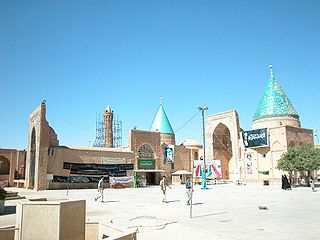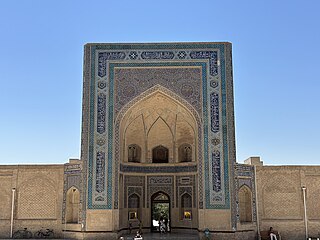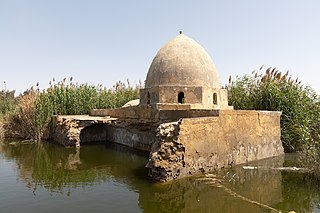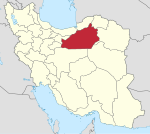
The Sanctuary of Imām 'Alī, also known as the Mosque of 'Alī, located in Najaf, Iraq, is a mausoleum which many Shia and Sunni Muslims believe contains the tomb of 'Alī ibn Abī Tālib, a cousin, son-in-law and companion of the Islamic prophet Muhammad. The Shī'as consider 'Alī as their first Imām and the first of the twelve caliphs of Muhammad, and the Sunnis regard him as the fourth Sunni Rashid Caliph. According to Shī'ite belief, buried next to 'Alī within this mosque are the remains of Adam and Nuh (Noah). Each year, millions of pilgrims visit the Shrine and pay tribute to Imām 'Alī.

Abū Yazīd Ṭayfūr bin ʿĪsā bin Surūshān al-Bisṭāmī (al-Basṭāmī), commonly known in the Iranian world as Bāyazīd Bisṭāmī, was a Persian Sufi from north-central Iran. Known to future Sufis as Sultān-ul-Ārifīn, Bisṭāmī is considered to be one of the expositors of the state of fanā, the notion of dying in mystical union with Allah. Bastami was famous for "the boldness of his expression of the mystic’s complete absorption into the mysticism." Many "ecstatic utterances" have been attributed to Bisṭāmī, which lead to him being known as the "drunken" or "ecstatic" school of Islamic mysticism. Such utterance may be argued as, Bisṭāmī died with mystical union and the deity is speaking through his tongue. Bisṭāmī also claimed to have ascended through the seven heavens in his dream. His journey, known as the Mi'raj of Bisṭāmī, is clearly patterned on the Mi'raj of the Islamic prophet Muhammad. Bisṭāmī is characterized in three different ways: a free thinking radical, a pious Sufi who is deeply concerned with following the sha'ria and engaging in "devotions beyond the obligatory," and a pious individual who is presented as having a dream similar to the Mi'raj of Muhammed. The Mi'raj of Bisṭāmī seems as if Bisṭāmī is going through a self journey; as he ascends through each heaven, Bisṭāmī is gaining knowledge in how he communicates with the angels and the number of angels he encounters increases.

An Iranian architect is traditionally called a mi'mar.

Damghan is a city in the Central District of Damghan County, Semnan province, Iran, serving as capital of both the county and the district.

Bastam is a city in, and the capital of, Bastam District of Shahrud County, Semnan province, Iran.

Po-i-Kalan, or Poi Kalan, is an Islamic religious complex located in Bukhara, Uzbekistan. The complex consists of three parts, the Kalan Mosque, the Kalan Minaret to which the name refers, and the Mir-i-Arab Madrasah. The positioning of the three structures creates a square courtyard in its center, with the Mir-i-Arab and the Kalan Mosque standing on opposite ends. In addition, the square is enclosed by a bazaar and a set of baths connected to the Minaret on the northern and southern ends respectively.

A mazār, also transliterated as mazaar, also known as marqad (مَرْقَد) or in the Maghreb as ḍarīḥ (ضَرِيْح), is a mausoleum or shrine in some places of the world, typically that of a saint or notable religious leader. Medieval Arabic texts may also use the words mašhad (مَشْهَد) or maqām to denote the same concept.

Imāmzādeh Ja‘far is a historical mausoleum in Borujerd, western Iran. The tomb contains the remains of Abulqāsim Ja’far ibn al-Husayn, grandson of the Shī‘ah Imam Ali ibn al-Husayn.

The Green Mosque, or the Mosque of Khawaja Abu Nasr Parsa is a mosque in the city of Balkh, northern Afghanistan. It contains the Shrine of Khwaja Abu Nasr Parsa. The mosque's name is derived from the kashi tiles on the walls of the mosque, which are coloured turquoise, known locally as Turkish Green.

Both Sunni Muslims and Shia Muslims agree on the three holiest sites in Islam being, respectively, the Masjid al-Haram, in Mecca; the Al-Masjid an-Nabawi, in Medina; and the Al-Masjid al-Aqsa, in Jerusalem.

The Tomb of Ahmad Sanjar is a mausoleum commemorating Ahmad Sanjar, a Seljuk ruler of Khorasan. It was built in 1157 in the medieval city of Merv in the Karakum Desert in Turkmenistan. Throughout his reign, Sanjar fought off several invasions and uprisings until finally being defeated by the Oghuz. After being sacked by the Oghuz, Merv declined and in 1221, the Mongols attacked it and burned down the mausoleum. It would later be restored by Soviet, Turkmen, and Turkish architects during the 20th and 21st centuries. The tomb is part of The State Historical and Cultural Park "Ancient Merv", a UNESCO World Heritage Site.

Imamzadeh Ismail and Shayah Mosque is a historical funerary religious complex in Isfahan, Iran, which dates back to both the Seljuk and Safavid periods. This complex is number 112 on the list of Iran's national monuments, and it comprises the Imamzadeh Ismail and the Shayah Mosque.

Al-Hannanah Mosque is a Shi'ite mosque in Najaf, Iraq. This mosque is also called Masjid ar-Raʾs, meaning "Mosque of the Head", because Husain's head was kept in its middle, while being taken to his opponent Ubayd Allah ibn Ziyad, according to a hadith (narration) attributed to his descendant, Ja'far al-Sadiq.

Sayyida Aisha Mosque is a mosque in Cairo, Egypt. It contains the tomb of Aisha bint Ja'far al-Sadiq, a female scholar who was one of the daughters of Ja'far al-Sadiq. The mosque is named after her, and it is located outside Citadel Square on a similarly named street.

Mausoleum of Yahya Abu al-Qasim was a historic shrine and mosque located in Mosul, Iraq. In 2014 the mosque and shrine were destroyed by an explosive device claimed by soldiers of the Islamic State of Iraq and Levant.

The Mashhad of Sayyida Ruqayya, sometimes referred to as the Mausoleum or Tomb of Sayyida Ruqayya, is a 12th-century Islamic religious shrine and mosque in Cairo, Egypt. It was erected in 1133 CE as a memorial to Ruqayya bint Ali, a member of the Islamic prophet Muhammad's family. It is also notable as one of the few and most important Fatimid-era mausoleums preserved in Cairo today.

Kalan Mosque is an architectural monument located in Bukhara, Uzbekistan. It was considered one of the largest mosques built on the place of Jame' Mosque. Its current appearance was built in 1514 during the reign of Shaybani Ubaidullah Khan of Bukhara. Currently, the mosque is included in the national list of estate real objects of material and cultural heritage of Uzbekistan.

The Mashhad al-Tabataba also known as the Mashhad al-Sharif al-Tabataba is a 10th-century mausoleum located in Cairo, Egypt. It was formerly located on the banks of the Ain el-Sira River, until it was relocated to the territory of the National Museum of Egyptian Civilization as part of a restoration attempt. It is the last surviving monument from the Ikhshidid period.

































